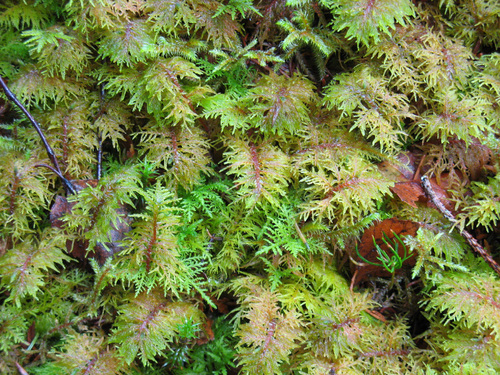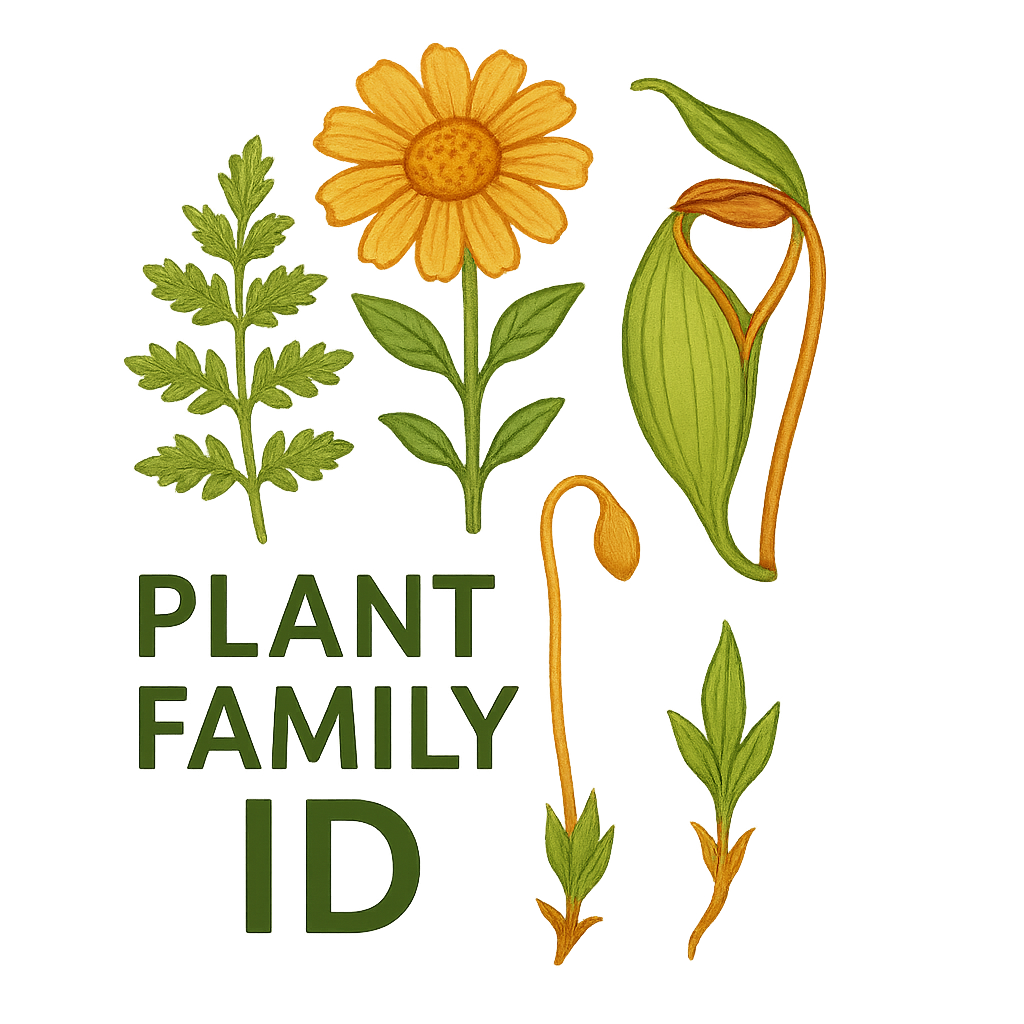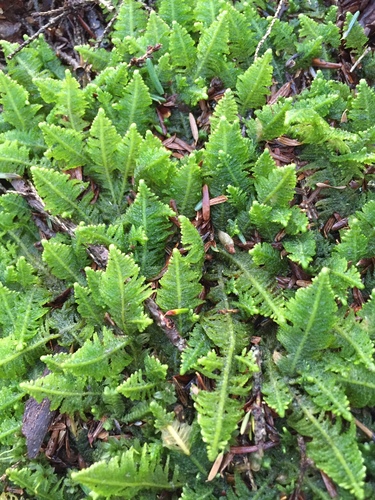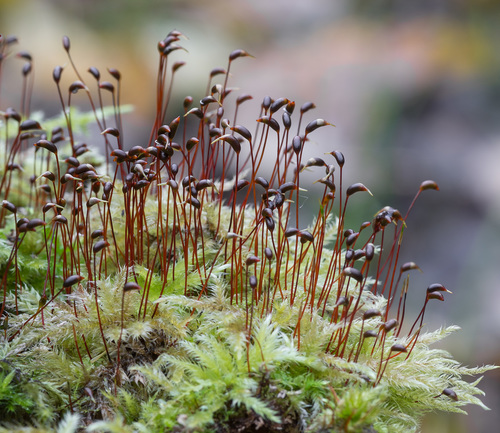Hylocomiaceae
Stairstep Moss Family / Feather Moss Family
Hylocomiaceae is a family of medium-sized to large, robust pleurocarpous mosses, primarily found in boreal and temperate forests and tundra of the Northern Hemisphere. They often form extensive mats or deep wefts on the forest floor, logs, or rocks. Key characteristics include frequently pinnate to bi- or tripinnate branching (giving a layered or "stairstep" look in Hylocomium), often reddish stems, abundant paraphyllia on the stems in many genera, broad and often plicate leaves, and a costa that is short and double or absent.

Overview
The Hylocomiaceae family, though relatively small with about 4-10 genera and 15-20 species, includes some of the most abundant and ecologically important mosses in northern forest ecosystems. Genera like Hylocomium, Pleurozium, and Rhytidiadelphus often dominate the ground layer in boreal coniferous forests, contributing significantly to biomass, nutrient cycling, and habitat structure.
These mosses are characterized by their robust, pleurocarpous growth, forming thick carpets on the forest floor, over logs and rocks, or in tundra heathlands. Their branching patterns are often highly organized and feathery, ranging from regularly pinnate to elaborately bi- or tripinnate. The "stairstep" moss, Hylocomium splendens, produces distinct annual layers of branching systems, creating a visually striking tiered structure. Many species have conspicuous reddish stems, and the presence of numerous small, filamentous or leafy outgrowths called paraphyllia on the stems is common (though absent in Pleurozium). Leaves are typically broad, concave, often folded (plicate), and lack a strong single midrib.
Sporophytes, when produced, feature typical Hypnalean characteristics: inclined to horizontal, ovoid capsules on long, smooth setae. However, some species, like Hylocomium splendens, produce sporophytes relatively infrequently. Phylogenetically, Hylocomiaceae is placed within the order Hypnales, often considered close to families like Thuidiaceae or Rhytidiaceae.
Quick Facts
- Scientific Name: Hylocomiaceae
- Common Name: Stairstep Moss Family, Feather Moss Family
- Number of Genera: Approximately 4-10
- Number of Species: Approximately 15-20
- Distribution: Primarily circumboreal (Northern Hemisphere), extending south in mountains.
- Habitat: Forest floor (humus, logs, rocks), heathlands, tundra; typically acidic conditions.
- Evolutionary Group: Bryophytes - Mosses (Class: Bryopsida, Order: Hypnales)
Key Characteristics
Growth Form and Habit
Plants are pleurocarpous, medium-sized to large and robust, forming loose to dense mats or deep, often extensive wefts. Branching is typically regular and pinnate to bi- or tripinnate, creating a feathery appearance. Hylocomium exhibits characteristic layered ('stairstep') growth.
Stems
Primary stems creeping, secondary stems ascending to erect, often stout and frequently reddish in color. Paraphyllia (small filamentous or leafy appendages on the stem surface) are often abundant and sometimes branched (e.g., Hylocomium, Rhytidiadelphus), but absent in Pleurozium.
Leaves
Stem leaves and branch leaves are often differentiated. Leaves are typically crowded, spreading to squarrose (spreading at 90° in Rhytidiadelphus squarrosus). Shape is usually broadly ovate, cordate (heart-shaped), or triangular-lanceolate, often strongly concave and frequently plicate (longitudinally folded). The apex is typically acute or acuminate, sometimes shortly pointed or rounded. Crucially, the costa is short and double, or absent (ecostate). Leaf cells are typically linear, smooth or sometimes prorate (with papillae projecting from cell ends). Alar cells are generally not strongly differentiated or forming distinct auricles.
Asexual Reproduction
Specialized asexual propagules are generally absent; reproduction occurs via fragmentation.
Sporophytes (Reproductive Structures)
Sporophytes arise laterally. The capsule is elevated on a long, typically smooth, often reddish seta. The capsule is generally ovoid to short-cylindric, usually inclined to horizontal, and often asymmetric or curved. The capsule wall is smooth. The peristome is double (diplolepidous), well-developed, and of the typical Hypnalean type. The operculum (lid) is usually conic to rostrate. Sporophytes can be uncommon in some species (Hylocomium, Pleurozium).
Habitat
Primarily found on the forest floor (humus, litter), decaying logs, rocks, and tree bases within coniferous or mixed forests (especially boreal forests), extending into heathlands and tundra environments. Typically associated with acidic substrates.
Field Identification
Identifying Hylocomiaceae relies on recognizing the robust, pleurocarpous growth, often organized branching patterns, habitat, and specific stem and leaf features.
Primary Identification Features
- Growth Habit: Robust, pleurocarpous mosses forming extensive mats or wefts.
- Branching Pattern (Key Feature): Often regularly pinnate to bi- or tripinnate; look for the distinctive layered 'stairstep' growth in Hylocomium.
- Habitat: Forest floor, logs, rocks in boreal/temperate forests or tundra.
- Stem Color/Paraphyllia: Stems often reddish. Check stems for presence of abundant paraphyllia (small filaments/scales) with a hand lens (absent in Pleurozium).
- Costa (Key Feature): Leaves have a costa that is short and double, or absent.
- Leaves: Broadly ovate or cordate, often strongly plicate.
Secondary Identification Features
- Leaf Apex/Arrangement: Check for squarrose leaves (R. squarrosus) or triquetrous arrangement (R. triquetrus).
- Sporophytes (if present): Ovoid, inclined capsules on long, smooth, often reddish setae.
Seasonal Identification Tips
- Year-round: The robust gametophytes with their characteristic branching patterns, stem color, and paraphyllia (if present) are visible year-round.
- Sporophyte Timing: Sporophytes, when produced, typically mature in spring or summer, but can be infrequent in some common species.
Common Confusion Points
Hylocomiaceae can be confused with other large, pinnately branched pleurocarps:
- Thuidiaceae: Also pinnately branched with paraphyllia, but generally finer, more delicate, branching more strictly regular (fern-like), leaf shape and cells differ.
- Hypnaceae (e.g., Ptilium crista-castrensis): Can be pinnate ('plume moss'), but lacks paraphyllia, costa short/double/absent, leaves often strongly falcate-secund.
- Brachytheciaceae: Have a single costa ending mid-leaf, lack paraphyllia.
- Rhytidiaceae (Rhytidium rugosum): Sometimes included in Hylocomiaceae. Has strongly transversely wrinkled (rugose) leaves and a single costa.
- Climaciaceae: Distinctly dendroid (tree-like) growth form.
Look for the combination of robust size, pinnate/bipinnate branching, often red stems, presence/absence of paraphyllia, and short/double/absent costa.
Field Guide Quick Reference
Look For:
- Habitat: Forest floor, logs, tundra
- Robust pleurocarpous mats/wefts
- Branching pinnate to bi/tripinnate (check for 'stairsteps')
- Stems often reddish
- Paraphyllia often present on stems (check!)
- Leaves broad, often plicate
- Costa short & double, or absent
Key Variations:
- Branching complexity (Hylocomium vs. others)
- Presence/absence of paraphyllia (Pleurozium)
- Leaf shape/arrangement (Rhytidiadelphus)
- Stem color intensity
Notable Examples
This family includes several very common and ecologically dominant mosses of northern ecosystems:

Hylocomium splendens
Stairstep Moss / Glittering Wood-moss
Highly distinctive due to its layered growth, forming new bipinnate fronds each year from the middle of the previous year's arching stem ('stairsteps'). Stems reddish, covered in branched paraphyllia. Common on forest floors.

Pleurozium schreberi
Red-stemmed Feather-moss / Schreber's Big Red Stem Moss
Extremely common, forming deep wefts in boreal forests and heathlands. Characterized by bright red stems (visible when leaves are parted), pinnate branching, concave ovate leaves lacking a costa (ecostate), and absence of paraphyllia.

Rhytidiadelphus squarrosus
Springy Turf-moss / Square Goose Neck Moss
Very common in lawns, pastures, grasslands, and open woodlands. Recognizable by its stiff stems with leaves strongly bent back at a right angle (squarrose), especially at the stem tips, giving a star-like appearance from above. Stems reddish, sparse paraphyllia present.

Rhytidiadelphus triquetrus
Big Shaggy-moss / Rough Goose Neck Moss
A large, robust, stiff moss forming loose, shaggy mats in woodlands, often on calcareous soil. Stems reddish, with paraphyllia. Leaves large, broadly triangular-ovate, strongly plicate, spreading widely in three ranks (triquetrous). Costa short and double.
Phylogeny and Classification
Hylocomiaceae is firmly placed within the class Bryopsida and the large order Hypnales. It represents a distinct lineage of robust, often pinnately branched pleurocarpous mosses typically found on the forest floor or in tundra.
Within Hypnales, its relationships are complex. It shares features like pinnate branching and paraphyllia with Thuidiaceae, and features like rugose or plicate leaves with Rhytidiaceae (sometimes merged with Hylocomiaceae). Molecular studies generally support Hylocomiaceae as a distinct family, possibly closely related to Rhytidiaceae and representing a significant clade within the Hypnales, separate from groups like Hypnaceae or Brachytheciaceae.
Position in Plant Phylogeny
- Kingdom: Plantae
- Division: Bryophyta (Mosses)
- Class: Bryopsida
- Subclass: Bryidae
- Order: Hypnales
- Family: Hylocomiaceae
Evolutionary Significance
Hylocomiaceae is significant for:
- Dominance in Boreal Ecosystems: Represents some of the most ecologically dominant ground-layer mosses in northern forests and tundra, playing major roles in ecosystem function.
- Complex Branching Patterns: Exhibits highly organized pinnate to tripinnate branching, showcasing morphological complexity in pleurocarpous mosses.
- Stem Structures: The presence and form of paraphyllia are important characters for understanding relationships within Hypnales.
- Adaptation to Forest Floor: Shows adaptations for growth in shaded, humid conditions on organic substrates.
- Phylogenetic Relationships: Helps clarify the evolutionary history and diversification within the large and complex Hypnales order.



